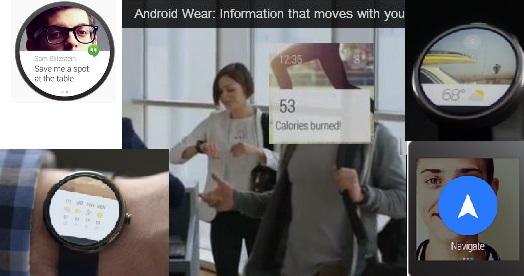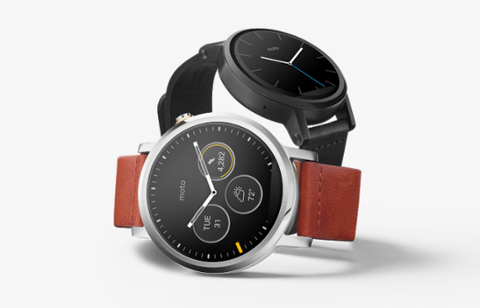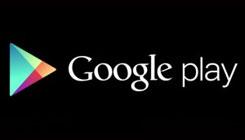Google Android Watch is a Phone Screen on Your Wrist
[caption id="attachment_18255" align="aligncenter" width="524"] Android Wear watches will show the same data as a phone... in theory.[/caption] It probably has nothing to do with the half-percent dip in Android's share of the smartphone market recorded earlier this month, but Google is pushing Android into the wearable computing market. Google's goal, as described in the March 18 blog announcing Android Wear, is to expand the role of watches beyond simply telling time, and make them something closer to personal assistants. Google has signed up a list of chip- and devicemakers to build watchlike devices that will link with phones to send and receive data; the hardware will contain sensors tracking motion, temperature, location, and anything else capable of being tracked by Android phones. The watch-ish mini-computers will run custom-built interfaces that are likely to be too small for detailed touch control and far too cramped for typing; instead, they will be able to respond to voice commands and transcribe spoken messages to text. Saying "OK Google" will activate an Apple Siri-like voice interface that will answer questions spoken in natural language and include task-management features that will call a taxi, send a text, set an alarm or make a restaurant reservation. It will also track an owner's fitness, using third-party fitness apps to display tracking data that would include real-time speed, distance and time spent on a run or walk, for example. (In a video accompanying the announcement, an Android Wear Watch tells a woman running to catch a plane how many calories she burned doing it, proving that even imaginary, super-optimized watches in marketing videos can be smart enough to know everything except how not to say the wrong thing at the right time.) The hardware will come primarily from Google's existing stable of phone-makers, though it has signed up fashion house Fossil Group to help design and distribute Android Wear watches, as well. Functions beyond the basics will come from "an expansive catalogue of apps," from developers Google is still in the process of courting. That's the key difference between Google's Android watches and those of other wearable manufacturers. Rather than seeing a wrist computer as a product in itself, Google seems to consider them as a convenient interface to a user's other devices. The watch may not have a 4G LTE cellular-network connection to look up the address of a restaurant or ability, to send email to request a reservation, but it knows where to find a phone that does. "Android Wear lets you access and control other devices from your wrist," according to Sundar Pichai, SVP, Android, Chrome & Apps, who wrote the blog posting announcing Android Wear. "Just say 'Ok Google' to fire up a music playlist on your phone, or cast your favorite movie to your TV." Android Wear watches will be "your key to a multiscreen world," according to the announcement, but many of the details that define whether it works or not will be largely up to someone else. "There's a lot of possibilities here, so we're eager to see what developers build," Pichai wrote. Developers, for their part, will get a fully polished Android Wear SDK later in the year. For now there is a an Android Wear Developer Preview site that promises the wearable version of Android will support the same APIs and respond to the same notifications as on phones or tablets. It will also include things like an activity-detection API that could trigger a "Can't reply right now, I'm cycling" message in response to messages, for example. Developers can use the preview to see how to adapt their user interfaces to much smaller screens that might be square or round. It also provides a set of design principles describing how users should experience Google watch apps. Wearable apps should be smart and contextually aware enough to recognize the user's location or activity level and display information appropriate to that activity. The interfaces have to be simple and "glanceable" so users can see useful information on them without shifting their attention from some other task, or see an alert in their peripheral vision. They should also require little or no interaction with the user; Android watches should autonomously provide information to users without being asked, and respond to minimal commands using voice or gestures. "Android Wear is like a great personal assistant: it knows you and your preferences. It only interrupts you when absolutely necessary and it's always on hand to provide a ready answer," according to the design preview site. All of that means Android Wear watches will likely ship with all the privacy controls turned off, in order to allow apps to learn as much about the user as possible, and use the Internet connections, email, Google+ and other online services as heavily as possible to gather information that would be most useful to the user at any time. According to anyone aware of the malware, spam, privacy invasions, data theft and user-profile-building marketing apps for which Android's phone and tablet versions have been the perfect host, "useful" information and personal assistance means an endless flow of advertisements, marketing offers, spam and come-ons from advertisers and marketing services signed up by developers without much oversight or control from Google. Google's guidance to developers doesn't say for sure, but it's also very likely most of the Android Wear watches will also be able to tell time, for users who can't reach the phones they've been using for that purpose for more than a decade. Image: Google



